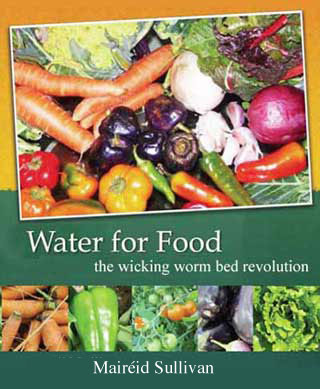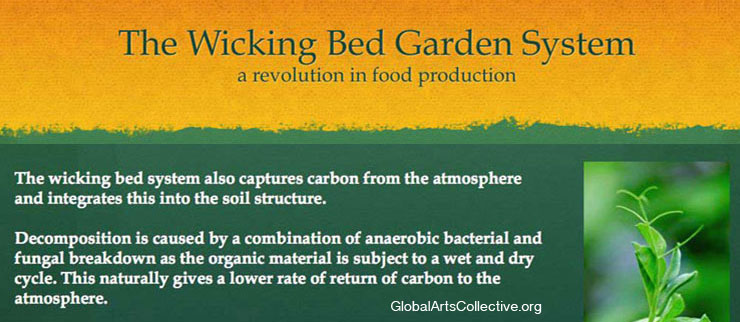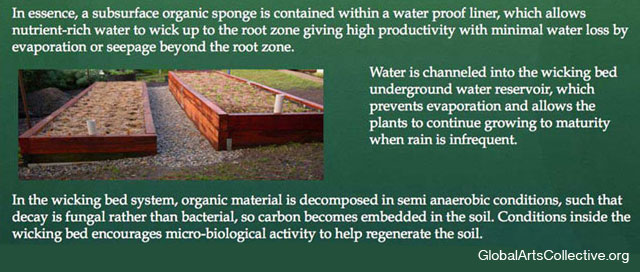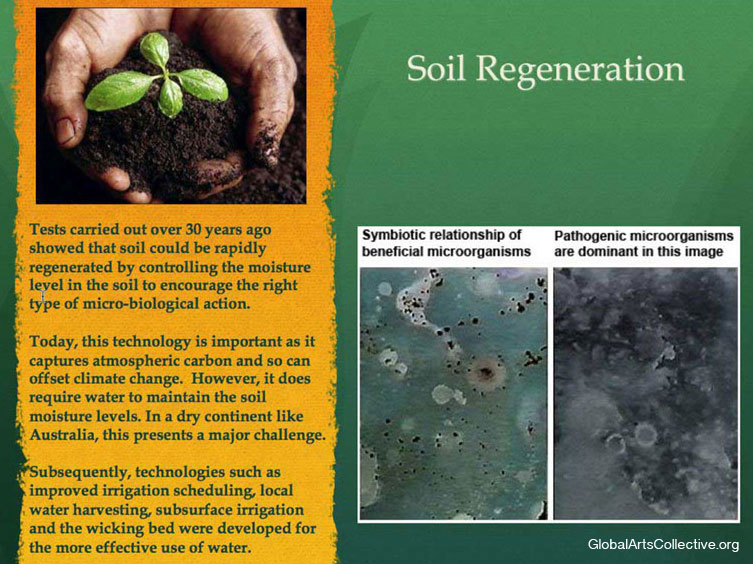DIY: Growing your own
"The wicking worm bed is a highly productive growing system which not only produces more food from limited water, but also recycles waste organic material to provide plant nutrient and capture carbon. The essence is to form an underground reservoir of water or pond contained by a waterproof container or liner below the surface of the soil. Plants are productive because they have a continuous supply of water and nutrients."
– Australian engineer Colin Austin, wicking bed inventor
Learn how to construct your own garden Wicking Worm Beds.
Water once a week in summer and much less during the rest of the year!
 Water for Food – Water for Food –
The wicking worm bed revolution
by Maireid Sullivan
(2009) Revised and expanded 2012
Download this FREE eBook - 4.3MB pdf format - here
This 20-page fully illustrated booklet, originally designed for powerpoint presentation, provides detailed information, including exact measurements and lists of materials needed for constructing timber-framed Wicking Worm Beds, plus everything you need to know about adding compost worms to the wicking beds.
Water doesn't evaporate in the reservoir under wicking beds. Instead, the water 'wicks' up to the roots, and the top soil remains 'soft' under the mulch. Since water will wick up only 300mm to the plant roots, the soil depth should be no more than 320mm deep (about one foot deep).
[Donation welcomed]
Excerpt 
Worm Power
Excerpt
Compost worms maintain a free source of nutrient-rich diet for plants, depending on the quality of the food scraps fed to them, and they provide a very good structure to the soil, keeping nutrients available by slow-release, and helping to retain water.
Microorganisms formed in a worm’s gut bind raw minerals from the soil to certain organic acids or sugars in a process called chelation. Plants can easily absorb these chelated forms of minerals. Worm castings are thought to contain a chitinase-enzyme, which melts the chitin that most insect exo-skeletons are made of. Worm castings act as a pest repellent/pesticide and act as a line of defense against pathogenic bacteria and fungi.
Composting worms will turn anything that was once alive into compost. Worm castings provide a high quality fertilizer, including calcium, magnesium, nitrogen, potassium & phosphorus and a broad spectrum of trace elements.
 |
Note: We use large plastic planter pots for our in-bed 'bio-boxes', aka a worm farm. These pots are the same plastic density as the commercially available worm farms which we've stopped using because, tragically, on one very hot day the worms melted! We've removed the base of the pot so that the worms can freely move from soil to compost. We use a slightly larger pot tray as a lid, adding many small ventilation holes, —with a stone on top to keep the lid on.
...
Bio Box:
It is easy to maintain a compost bio-box directly on the wicking bed, where bacteria, fungi, and worms can breed up and re-fertilize the soil. An in-ground bio-box makes it easier to regularly top up with organic waste, directly from the kitchen and the garden, and especially convenient while picking food for the table.
Using a worm farm or Bio Box can dramatically increase compost recycling, creating a rich organic blend of nutrients and trace elements high in humates, beneficial bacteria and fungi, ideal for plant growth & soil conditioning, that will enhance the flavour and quality of your back yard produced vegetables. The effective area of your worm farm increases the worm farm size to the actual size of your garden bed. This could be up to a ten-fold increase in capacity. The worms will reproduce to fill the volume of the garden bed. The only restriction to their numbers will be the amount of food scraps you feed them. They can never over breed as they have a natural mechanism to stop breeding when overcrowded. What this means is that you can recycle up to ten times the amount of scraps over a conventional worm farm.
When you see two dozen worms per shovel full of soil, the worms will maintain the soil quality for you.
“You’ll have a worm farm that is buffered from the weather. If the sun is too strong and heats up the worm farm during the day, the worms will escape into the soil, but they will return as soon as the sun sets. If it is very cold the worms will also escape the worm farm into the warmer soil and come back up for a feed when the weather warms up. You‘ll no longer need to do the extra work of removing the worm castings from your worm farm and manually incorporating it into your garden bed. The worms now do this work for you. The worms will come up and down through the holes in the base of the worm farm. The worms will come into the worm farm to eat the scraps, then they will leave the worm farm and spread their cast throughout the garden bed for you. All you have to do is keep feeding them the scraps directly into the worm farm.” Source: Kookaburra Worm Farms
It is now over a decade since the wicking bed concept was developed and the first bed installed. Since that time numerous environmentally sensitive growers have confirmed water saving and improved productivity. The reduced waste of nutrient-rich water to the water table is self-evident. The improved soil quality is evident to growers with a feel for soils, so there is little doubt that the organic content of the soil is increasing.
"In a healthy ecosystem, vibrant, living soils are a dynamic part of the carbon cycle. The carbon compounds added to soil as exudates from active plant roots and the decomposition of plant and animal residues, fuel the biological processes that improve soil structure, which in turn increases oxygen and moisture retention and creates better conditions for more life. . . .soils are a dynamic part of the carbon cycle” – Dr Christine Jones, 2006
|
 |
|

Go to: - Sustainable Argiculture
Back to top |

